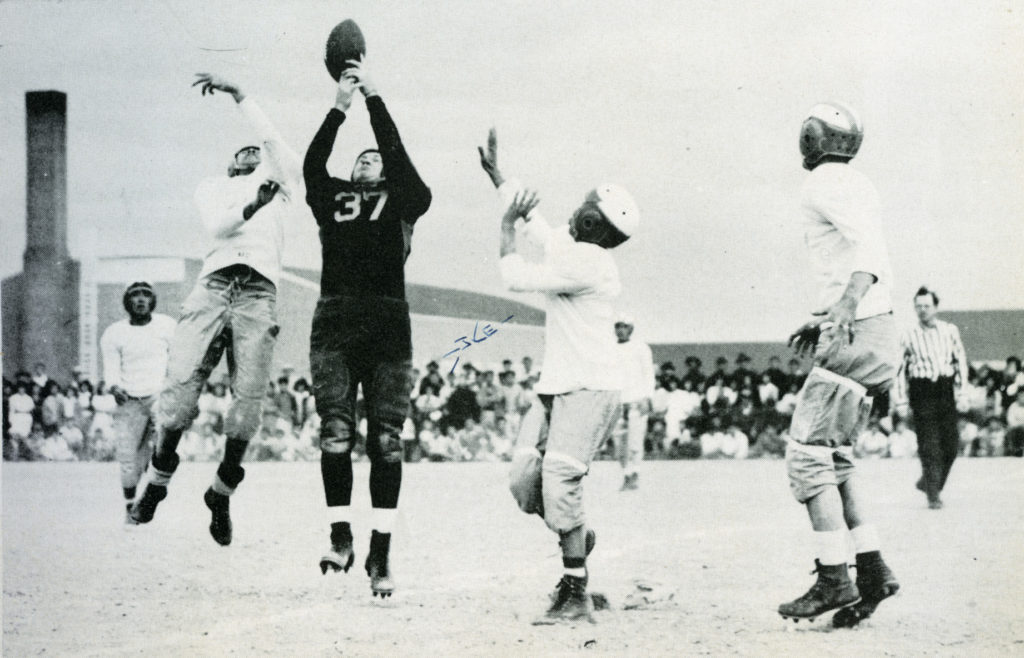November 16, 2021
Densho Content Director Brian Niiya reviews The Eagles of Heart Mountain by Bradford Pearson, an entertaining and well-researched popular history of the incarceration told through the story of a group of young football players at Heart Mountain.
It’s not that often that we get books about some aspect of the wartime incarceration of Japanese Americans from major commercial presses, but in the last year, we’ve had a couple of notable ones. Densho followers certainly know about Daniel James Brown’s Facing the Mountain: A True Story of Japanese American Heroes in World War II, which came out earlier this year complete with an introduction by our director, Tom Ikeda. Though on a different topic, Bradford Pearson’s The Eagles of Heart Mountain: A True Story of Football, Incarceration, and Resistance in World War II America is a similar book in that it ably tells a larger story through the eyes of a handful of young Nisei men bound by a common experience. But instead of war, the experience the men share is that of football, the sport of war metaphors.

The main characters in the book are George “Horse” Yoshinaga, Babe Nomura, Stan Igawa, and Tosh Asano, each drawn to football in different ways. The book uses the stories of Horse, from a Mountain View farming family, and Babe, from a Hollywood family that ran a boarding house, to tell the larger stories of Japanese immigration and settlement, and the rise of the Nisei generation. After the attack on Pearl Harbor, Pearson follows the two families to Santa Anita and Heart Mountain. At the latter, they meet Igawa, who grew up on the Big Island of Hawai`i and in Los Angeles and came to Heart Mountain via the Pomona Assembly Center, and Asano, Nomura’s football rival from L.A.
The main storyline follows the Heart Mountain High School football team through their tumultuous 1943 and 1944 seasons. Led by the new PE teacher, Ray Thompson, the football team had just three players who had played for their high school teams, including Horse and Babe. In a matter of days, the team came together. Thompson’s status as a local sports hero gave him the clout to schedule games with local high schools, and three teams make the trip to Heart Mountain to play the Eagles. Despite their inexperience, they win every game and go unscored upon. A final game against a camp all-star team matches prewar rivals Nomura and Asano, with Nomura’s Eagles winning the game. The 1944 season brings more of the same: success on the field on the one hand, difficulty scheduling opponents on the other, and a bittersweet ending. Pearson juxtaposes the story of the team with the larger story of Heart Mountain, in particular the drama of the Heart Mountain Fair Play Committee and the two associated trials that took place as the season unfolded.
A final chapter follows the team members into their post-camp life that represents the varied paths Nisei men took. A couple—including one who resisted the draft—become gardeners, and Igawa takes a circuitous journey to becoming a high school principal in Hawai`i. Babe returns to LA and becomes a star football player at Los Angeles City College and San Jose State, cementing his status as one of the best Nisei athletes. Horse became a sports promoter and columnist, writing his conservative Horse’s Mouth column for the Kashu Mainichi and Rafu Shimpo for decades. (I tangled with him a few times in my days as a Rafu columnist.)
There are inevitably a few hiccups in the history — for example, Pearson has the hospital chimney “puffing” and all of the barracks completed as the first inmates arrive at Heart Mountain when, as was true at the other WRA camps, Heart Mountain was only partially constructed when the first inmates arrived. But overall, Eagles does a good job of appealing to both those of us who know a lot about the incarceration and those of us who know little. Particularly for sports fans, it would make a fine introduction to the story of the roundup and incarceration.
—
By Brian Niiya, Densho Content Director
Note: Densho is acknowledged in the book text, with Pearson writing that our “digital archive and encyclopedia provided my crash course in Japanese American history.”
Learn more about The Eagles of Heart Mountain: A True Story of Football, Incarceration, and Resistance in World War II America (Atria Books, 2021) by Bradford Pearson here.
[Header: The Eagles in a football game at Heart Mountain. Courtesy of Bradford Pearson and the Heart Mountain Wyoming Foundation.]


